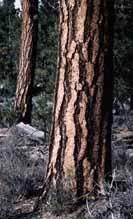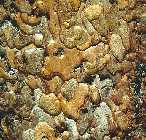
Mature ponderosa (subsp. ponderosa ) growing in a selectively logged area, Big Hole, Oregon [C.J. Earle, 17-Apr-1998].

Bark, about 30 cm across, on a specimen of subsp.
ponderosa
[C.J. Earle].
Common Names
Ponderosa pine, yellow pine, pino real, pinabete (3); western yellow, bull, black Jack, western red, western pitch, big, heavy, Sierra brownbark, western longleaf or ponderosa white pine (4); pin à bois lourd (1).Taxonomic notes
Discovered by David Douglas in 1826 near what is now Spokane, Washington (5) and described by Lawson in 1836. Since that time, the taxonomy of the ponderosa complex has been the subject of continuing dispute. The classification used here is sufficiently distinctive that it has not yet received formal description, but it does represent the fruits of considerable scholarship conducted by Lauria (10, 11, 12) and Frankis (previously unpublished).
Forestry studies (6, 7, 8, 9) indicate the existence of four distinct taxa termed 'races' (6, 8, 9) or 'ecotypes' (7). These taxa are morphologically distinct (10, 11, 12) and would normally be treated as subspecies, but most have not been formally described at this rank. They have all been described at species rank in the past. The following names, not all of which have been formally published, here used here:
P. ponderosa subsp. ponderosa . The 'North Plateau' group includes populations formerly assigned to P. washoensis H. L. Mason & Stockwell (which is arguably a distinct taxon at the varietal rank), as well as those conventionally assigned to P. ponderosa subsp. ponderosa from British Columbia, western Montana, Idaho, and Washington, Oregon, California & Nevada east of the Cascades crest.
P. ponderosa subsp. benthiama (not published). The 'Pacific' group includes populations formerly assigned to Pinus benthamiana Hartweg (1847) from the Sierra Nevada and west of the Cascade crest in California, Oregon and Washington.
P. ponderosa subsp. brachyptera (not published). The 'South Rockies' group includes populations formerly assigned to Pinus brachyptera Engelmann (1848) from Arizona and New Mexico. In the far south of those states, it is replaced by Pinus arizonica (q.v.).
Pinus ponderosa subsp. scopulorum (Engelmann) E. Murray. The 'North Rockies' group, currently-described, is widely distributed to the east and north of the above-named taxa.
Description
Trees to 18-39(72) m with 80-120(250) cm diameter, straight; crown broadly conic to rounded. Bark yellow- to red-brown, deeply irregularly furrowed, cross-checked into broadly rectangular, scaly plates. Branches descending to spreading-ascending; twigs stout (to 2 cm thick), orange-brown, aging darker orange-brown, rough. Buds ovoid, to 2 cm, 1 cm broad, red-brown, very resinous; scale margins white-fringed. Needles 2-5 per fascicle, spreading to erect, persisting (2)4-6(7) years, 7-25(30) cm × (1)1.2-2 mm, slightly twisted, tufted at twig tips, pliant, deep yellow-green, all surfaces with evident stomatal lines, margins serrulate, apex abruptly to narrowly acute or acuminate; sheath 1.5-3 cm, base persistent. Staminate cones ellipsoid-cylindric, 1.5-3.5 cm, yellow or red. Ovulate cones maturing in 2 years, shedding seeds soon thereafter, leaving rosettes of scales on branchlets, solitary or rarely in pairs, spreading to reflexed, symmetric to slightly asymmetric, conic-ovoid before opening, broadly ovoid when open, 5-15 cm, mostly reddish brown, sessile to nearly sessile, scales in steep spirals (as compared to Pinus jeffreyi ) of 5-7 per row as viewed from side, those of cones just prior to and after cone fall spreading and reflexed, thus well separate from adjacent scales; apophyses dull to lustrous, thickened and variously raised and transversely keeled; umbo central, usually pyramidal to truncated, rarely depressed, merely acute, or with a very short apiculus, or with a stout-based spur or prickle. Seeds ellipsoid-obovoid; body (3)4-9 mm, brown to yellow-brown, often mottled darker; wing 15-25 mm (1, 5).Range
Canada: S British Columbia, E to US: SW North Dakota, S to trans-Pecos Texas and W to S California; also in Mexico: Baja & Sonora (1, 5). Mostly in the mountains, in pure stands or mixed conifer forests (5).Big Tree
See subspecies benthamiana .Oldest
See subspecies scopulorum .Dendrochronology
Ethnobotany
The most commercially important western pine (5). Extensive harvest has eliminated vast acreages of old growth ponderosa.Observations
See the variety descriptions.Remarks
The most widely distributed and common pine in North America. Quail, squirrels and many other kinds of wildlife consume the seeds, and nutcrackers and chipmunks cache them, thereby helping to bring forth new pines (5).Although it is currently the most abundant pine in the west, Ponderosa may have been virtually absent from the west during the glacial and pluvial climates that characterized most of the Pleistocene epoch. In these periods, which account for 80 to 90 percent of the last two million years, ponderosa has only been found to occur along the Mogollon Rim in central Arizona. However, the morphological and genetic diversity of the species suggests that other Pleistocene refugia are likely to have occurred in California and probably elsewhere.
Ponderosa is one of the best examples of the superb adaptation to wildfire that characterizes much of the genus Pinus . Studies in the Gila Wilderness area of Arizona and New Mexico have found that due to frequent summer lightning storms and the accumulation of pine needles on the forest floor, low intensity surface fires may travel through ponderosa stands with an average frequency of once every three years. These frequent burns discourage competitive species such as scrub oak and shade tolerant conifers. Adult ponderosa are unharmed by such fires due to their thick, fire resistant bark, while ponderosa seedlings also have an excellent chance of surviving these low-intensity burns. In the historical period, an enthusiastic program of fire suppression has virtually eliminated these small, frequent fires. As a consequence, shrubs and shade-tolerant conifers have invaded many ponderosa stands while thick accumulations of highly combustible fuels have built up on the forest floor. Now, when a fire does occur, it is likely to be extremely destructive, destroying vast stands of prime forest. In the last 20 years, some forest managers have attempted to reintroduce low intensity fire to this ecosystem, but their efforts are often thwarted both by a"Smokey the Bear" mentality ingrained in the public mind, and by the high cost of monitoring prescribed fire in an ecosystem that has accumulated high fuel loads.
Ponderosa pine ( Pinus ponderosa ) is the state tree of Montana (1).
Citations
(1) Kral in Flora of North America online .(3) Elmore & Janish 1976 .
(4) Peattie 1950 .
(5) Little 1980 .
(6) R. H. Weidmann. 1939. Evidences of racial variation in a 25-year test of Ponderosa Pine. Journal of Agricultural Research 59: 855-868.
(7) O.O. Wells. 1964. Geographic variation in Ponderosa Pine, I. Silvae Genetica 13: 89-103.
(8) W.B. Critchfield. 1984. Crossability and relationships of Washoe pine. Madroņo 31: 144-170.
(9) M.T. Conkle and W.B. Critchfield. 1988. Genetic variation and hybridization of Ponderosa Pine. Pp. 27-43 in: D.M. Baumgartner & J.E. Lotan, Ponderosa Pine: the species and its management , Symposium Proceedings, Washington State University, Pullman.
(10) F. Lauria. 1991. Taxonomy, systematics, and phylogeny of Pinus, subsection Ponderosae Loudon (Pinaceae). Alternative concepts. Linzer Biol. Beitr. 23: 129-202.
(11) F. Lauria. 1996. Typification of Pinus benthamiana Hartw. (Pinaceae), a taxon deserving renewed botanical examination. Ann. Naturhist. Mus. Wien 98 B Suppl.: 427-446.
(12) F. Lauria. 1996. The identity of Pinus ponderosa Douglas ex C Lawson (Pinaceae). Linzer Biologische Beitraege 28(2): 999-1052. ABSTRACT: Pinus ponderosa s.l. is a commercially important and polymorphic conifer. its taxonomy (and that of its entire group, the 'ponderosa complex') is far from being settled (Kral 1993). This unsettled status is largely due to absence of a type, a circumstance which also accounts for the fact that even the very identity of Pinus ponderosa s.str. itself is notoriously confused. The earliest sources documenting the intricacies of the discovery and late publication of ponderosa pine as a new species in 1836 are reviewed. Detailed study of its earliest botanical history is demonstrated to be essential to finally establish its original identity, as meant by David Douglas and described by Charles Lawson. Pinus ponderosa Douglas ex C. Lawson is then neotypified with authentic material (an ovuliferous cone) discovered in a historical collection of conifer cones surviving at the Natural History Museum in Vienna, Austria (W). The extensive synonymy pertaining to the 'ponderosa complex' is reviewed (including typification of several of these synonyms) and some new facets of the life and achievements of David Douglas, who is commonly credited with the discovery of Pinus ponderosa , are also reported here for the first time.
(13) J.W. Duffield & W.C. Cumming. 1949. Does Pinus ponderosa occur in Baja California? Madroño 10: 22-24.
See also:
Burns & Honkala 1990
.
Lanner 1983
.
FEIS database
.
This page largely written by M.P. Frankis, Dec-1998.
back | Pinus | Pinaceae | home
This page is from the Gymnosperm Database
URL: http://www.geocities.com/~earlecj/pi/pin/ponderosa.htm
Edited by Christopher J. Earle
E-mail:
earlecj@earthlink.com
Last modified on 31-Oct-1999